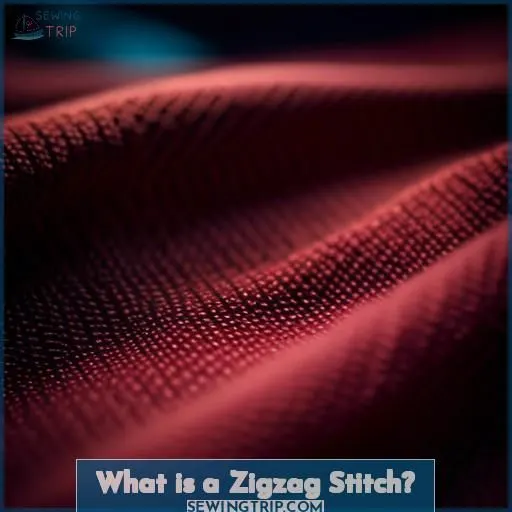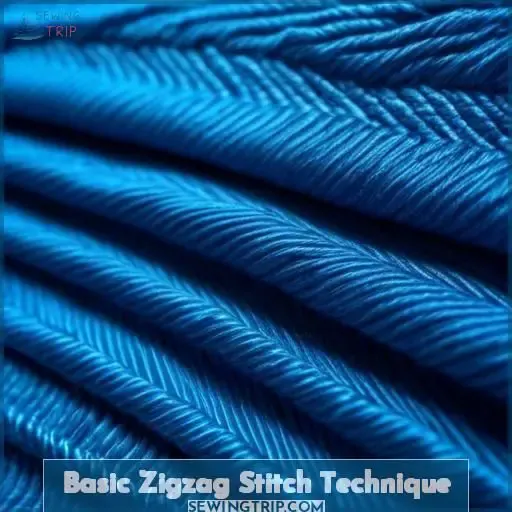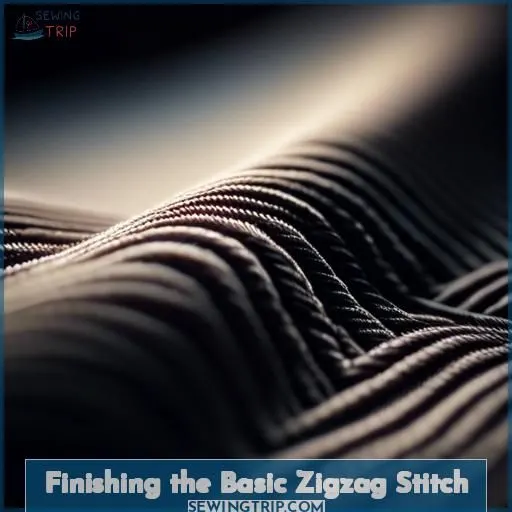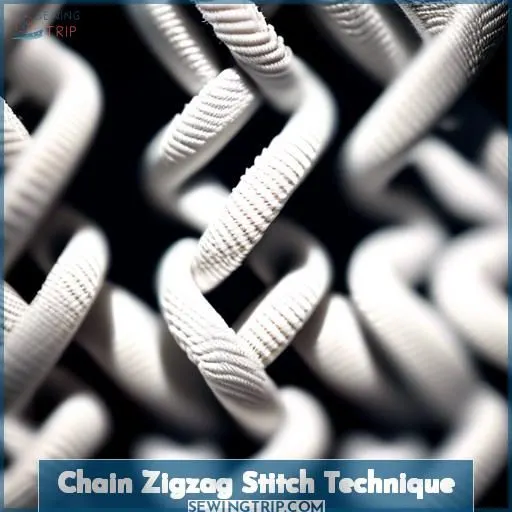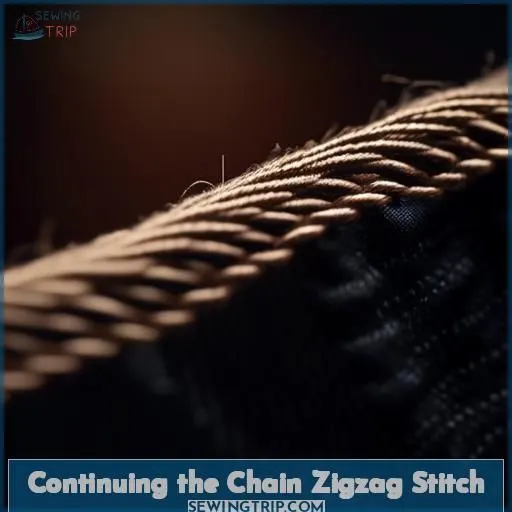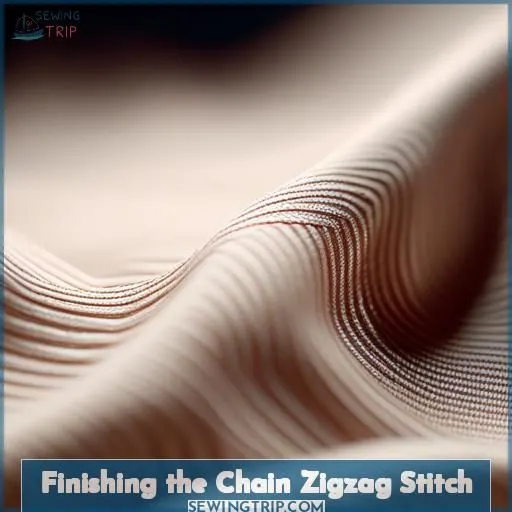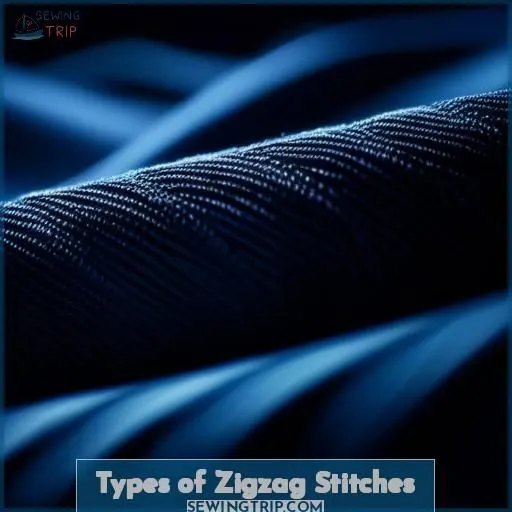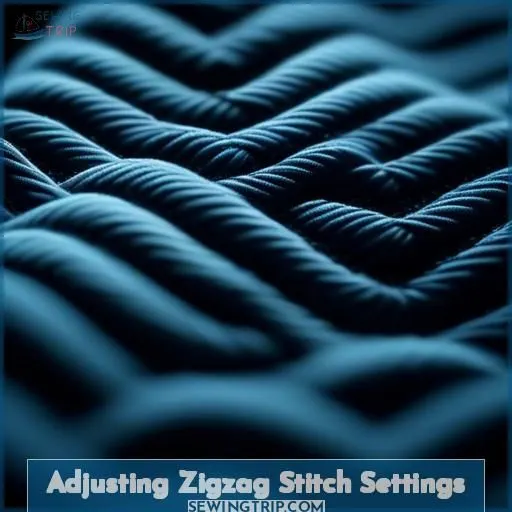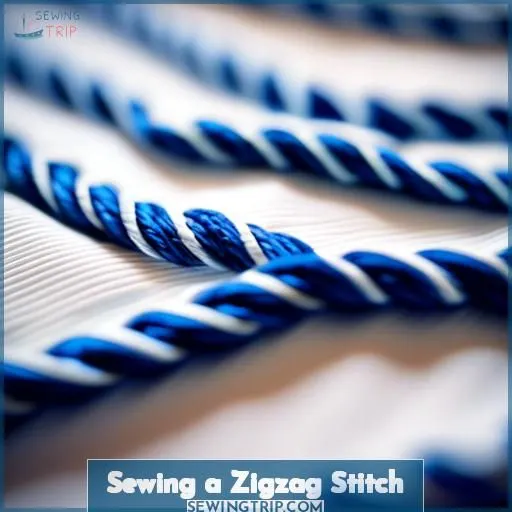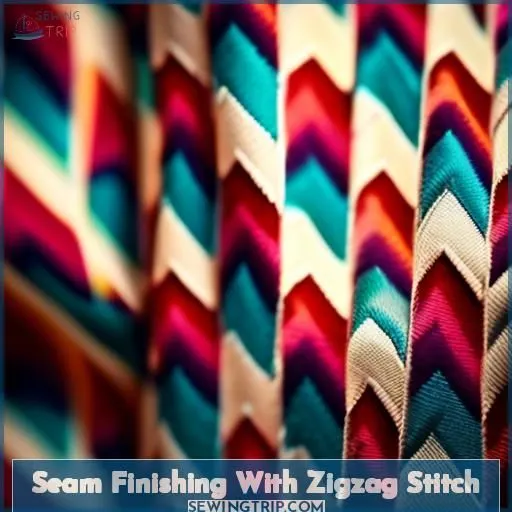This site is supported by our readers. We may earn a commission, at no cost to you, if you purchase through links.
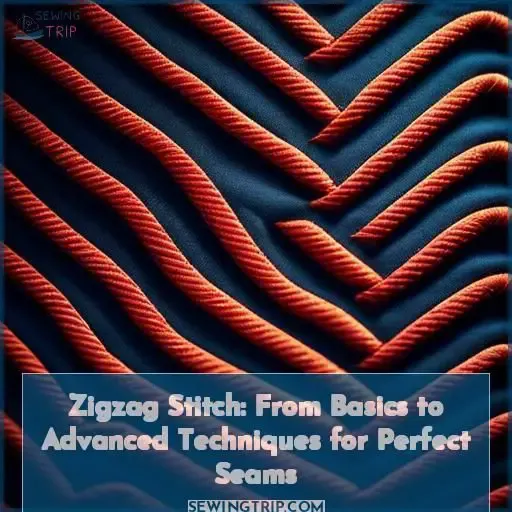 Probe the zigzag stitch’s versatility from basic techniques to advanced applications for flawless seams.
Probe the zigzag stitch’s versatility from basic techniques to advanced applications for flawless seams.
You’ll acquire proficiency in this sturdy, side-to-side geometric stitch used for seam finishing, decorative sewing, and handling stretch fabrics.
Mastering the zigzag delivers secure fabric attachment, fraying prevention, and seamless appliqué integration.
Gain comprehensive knowledge to elevate your sewing skills with this adaptable stitch.
Table Of Contents
- Key Takeaways
- What is Zigzag Stitch?
- What is a Zigzag Stitch?
- Basic Zigzag Stitch Technique
- Finishing the Basic Zigzag Stitch
- Chain Zigzag Stitch Technique
- Continuing the Chain Zigzag Stitch
- Finishing the Chain Zigzag Stitch
- Types of Zigzag Stitches
- 3. step Zigzag Stitch: a Preset Decorative Stitch Used for Sewing Lingerie and Stretch Fabrics
- Narrow Zigzag Stitch: Used for Seam Finishing and Sewing Stretch Fabrics
- Satin Stitch: a Closely Spaced Zigzag Stitch Used for Applique and Buttonholes
- Standard Zigzag Stitch: a Versatile Stitch Used for Various Purposes
- Wide Zigzag Stitch: Used for Decorative Purposes
- Adjusting Zigzag Stitch Settings
- Sewing a Zigzag Stitch
- Seam Finishing With Zigzag Stitch
- Frequently Asked Questions (FAQs)
- Conclusion
Key Takeaways
- A zigzag stitch is a versatile, side-to-side stitch used for seam finishing, decorative sewing, and sewing stretch fabrics.
- It is a sturdy stitch that can hold fabrics together tightly, prevent fraying, and attach appliqués.
- The zigzag stitch is suitable for various fabric types, including woven and knit fabrics.
- To master the zigzag stitch, one must understand the basics, adjust stitch settings according to fabric type and project requirements, and practice various techniques for seam finishing, decorative sewing, and handling stretch fabrics.
What is Zigzag Stitch?
A zigzag stitch is a type of stitch used in sewing that creates a pattern of diagonal lines. It is often used for seam finishing, decorative sewing, and sewing stretch fabric. The stitch can be adjusted by changing the settings on the sewing machine, with higher numbers on the stitch length making the zigzag longer and the width dial indicating the width of the stitch.
It is particularly useful for sewing lingerie and stretch fabrics, and can be used to prevent fraying on raw edges or to create decorative edging. The stitch is easy to recognize and can be done by hand, although most sewing machines have a zigzag stitch setting.
What is a Zigzag Stitch?
A zigzag stitch is a geometric side-to-side stitch used for seam finishing, decorative sewing, and sewing stretch fabric. It’s a sturdy stitch that can be used to hold fabrics together tightly and is often used to prevent fraying and to attach appliques.
A Geometric Side-to-side Stitch Used for Seam Finishing, Decorative Sewing, and Sewing Stretch Fabric
A zigzag stitch is a versatile, side-to-side stitch used for seam finishing, decorative sewing, and sewing stretch fabric. It’s a sturdy stitch that can hold fabrics together tightly, preventing fraying and ideal for applique reinforcement. The chain zigzag stitch, for instance, adds decorative chain link details, while adjusting stitch settings can tailor the stitch for specific needs.
A Zigzag Stitch is a Sturdy Stitch That Can Be Used to Hold Fabrics Together Tightly
A zigzag stitch is a sturdy stitch that can be used to hold fabrics together tightly, making it a versatile choice for various sewing projects. It’s not only suitable for seam finishing but also for decorative applications, such as creating borders, stripes, or other shapes on garments or home decor projects. For beginners, it’s essential to choose the correct stitch length and width, as well as adjust the needle thread tension to ensure the zigzag stitch lies flat against the fabric without tunneling.
When it comes to seam strength, the zigzag stitch has an advantage, especially for fabrics that require some degree of elasticity. Its back-and-forth movement helps distribute stress across the seam, reducing the likelihood of thread breakage. Additionally, the zigzag stitch can be used to attach appliques, sew elastic to knit fabrics, finish raw edges, and sew knit fabrics.
To sew a zigzag stitch, lower the presser foot and sew three stitches forward, reverse, and continue sewing. Adjust the stitch length and width according to the fabric type and desired appearance. It’s also recommended to test the stitch on a scrap of fabric before using it on the project.
For seam finishing, it’s important to trim seams to a width of 7mm (1/4in) and set the machine to zigzag stitch. Line up the fabric edges with the foot guide and stitch the seam allowances, ensuring the zigzag reaches the fabric edge. Backtack or tie threads to secure the stitch, and press the seams open or to one side.
In conclusion, a zigzag stitch is a durable and versatile stitch that can be used for various sewing applications. By understanding the basics and adjusting the stitch settings according to the fabric type and project requirements, you can achieve strong, flexible, and attractive seams.
It is Often Used to Prevent Fraying and to Attach Appliques
A zigzag stitch is a versatile technique used in sewing to prevent fraying and attach appliques.
By using a zigzag foot, you can trim seams to a width of 7mm (1/4in) and stitch seam allowances together.
The satin stitch is particularly effective for applique work, while overcast stitching is designed to enhance raw edges.
A zigzag presser foot can help navigate the complexities of this stitch.
It is not merely a decorative element; it underpins the strength of your seams.
Basic Zigzag Stitch Technique
Start your zigzag stitch by inserting the needle at point A and crossing the fabric at point B. Continue by inserting the needle again at point A and crossing the fabric at point C.
Start by Inserting the Needle at Point a and Crossing the Fabric at Point B
Diving into the zigzag stitch, you’ll want to:
- Pick the right needle and presser foot for your fabric’s dance.
- Choose your thread tension like you’re tuning a guitar.
- Decide between a sassy narrow or bold wide zigzag.
- Set your stitch length to match the rhythm of your project’s beat.
Continue by Inserting the Needle at Point a Again and Crossing the Fabric at Point C
To continue the basic zigzag stitch technique, insert the needle at point a again and cross the fabric at point c.
This creates another zigzag stitch that will help strengthen the seam and prevent fraying.
Remember to adjust the needle thread tension and choose the correct zigzag stitch setting on your sewing machine for the best results.
For woven fabrics, you can use a standard zigzag stitch, while for knit fabrics, a narrow zigzag stitch or satin stitch may be more appropriate.
Always test your stitch on a scrap of fabric before using it on your project to ensure it meets your needs and looks as desired.
Repeat These Steps for the Entire Row and End With a Vertical Stitch
To complete a basic zigzag stitch, you’ll need to repeat the steps of inserting the needle at point A, crossing the fabric at B, and so on, for the entire row.
End the row with a vertical stitch, which can be a decorative stitch or a standard one.
The length and width of the stitches, as well as the seam allowances, can be adjusted to suit your project.
It’s recommended to use an overedge foot for this stitch type.
Finishing the Basic Zigzag Stitch
Finish the basic zigzag stitch by crossing the final vertical stitch and inserting the needle at point G. Zigzag stitch down the row and overlap the first vertical post to complete the stitch.
Cross the Final Vertical Stitch and Insert the Needle at Point G
Cross the final vertical stitch and insert the needle at point G. Adjust the zigzag width, tension, and foot pressure for seam strength. Zigzag stitches down the row, ending by overlapping the first vertical post. Knot the thread and cut off excess.
Zigzag Stitches Down the Row and End by Overlapping the First Vertical Post
After crossing that final vertical stitch, you’re on the home stretch. Here’s how to nail it:
- Zigzag overlap ensures a neat finish.
- Precise needle placement beats fabric thickness.
- Adjust thread tension for smooth horizontal stitches.
If Done Correctly, the Needle Should Be at the Back of the Fabric
To achieve the best results with a zigzag stitch, ensure the needle is placed at the back of the fabric.
This is particularly important when finishing the basic zigzag stitch.
The needle should be oriented in the correct direction, with the stitch length and thread choice appropriate for the fabric and seam type.
Whether you’re working with a standard zigzag stitch, a 3-step zigzag stitch, or diagonal seams, proper needle placement is crucial for perfect seams.
Knot the Thread and Cut Off Any Excess
To finish the basic zigzag stitch, knot the thread and cut off any excess.
Knot placement should be at the back of the fabric.
Choose a thread color that complements your project.
For quilting, use a walking foot and adjust stitch length and thread weight accordingly.
Backtacking method varies depending on presser foot type.
Press quilt top and binding with a pressing cloth.
Chain Zigzag Stitch Technique
Start the chain zigzag stitch by inserting the needle at point A and then at point AA. Slide the needle along the back of the fabric and position the thread underneath the needle.
Insert the Needle at Point a and Then at Point AA
To create a chain zigzag stitch, insert the needle at point A and then at point AA.
Slide the needle along the back of the fabric, position the thread underneath, and pull the needle and thread through the fabric.
Insert the needle at BB and poke it through at C to create another chain link.
Continue making chains across the row.
Finish the stitch by tying a knot at the end.
This technique is essential for seam finishing, especially for stretch fabrics, and is a basic yet powerful tool in the world of zigzag stitching.
Slide the Needle Along the Back of the Fabric and Position the Thread Underneath
To create a chain zigzag stitch, you’ll need to slide the needle along the back of the fabric and position the thread underneath. This process is crucial for maintaining the correct chain stitch tension and achieving the desired coverage.
- Start by inserting the needle at point A and then at point AA.
- Slide the needle along the back of the fabric, ensuring that the thread is positioned underneath.
- Pull the needle and thread through the fabric, creating a loop.
- Repeat steps 2 and 3 for each chain link, ensuring that the needle is always positioned underneath the previous loop.
- Continue making chains across the row, always sliding the needle along the back of the fabric and positioning the thread underneath.
Remember to adjust the chain stitch tension as needed to achieve the desired coverage and stability. This technique is often used for decorative purposes, such as in the Zigzag Twisted Chain Stitch, which can produce beautiful patterns when used on borders.
Pull the Needle and Thread Through the Fabric
To complete the chain zigzag stitch, pull the needle and thread through the fabric.
- Start at point AA and slide the needle along the back of the fabric.
- Position the thread underneath the needle and pull it through the fabric.
- Repeat this process at point BB and poke the needle through at point C.
- Create another chain link and continue making chains across the row.
Remember to adjust the needle thread tension and choose the correct zigzag stitch setting for best results. Practice on samples to perfect your technique.
Continuing the Chain Zigzag Stitch
Insert your needle at point BB and poke it through at point C. Continue making chain links across the row.
Insert the Needle at Point BB and Poke It Through at Point C
To continue the chain zigzag stitch, insert the needle at point BB and poke it through at point C.
This creates another chain link.
Be mindful of needle alignment, thread tension, and presser foot choice.
Zigzag stitch settings should be chosen based on the fabric type and desired outcome.
Test stitch outs on scraps before using on athletic wear or dancewear.
Create Another Chain Link and Continue Making Chains Across the Row
To continue the chain zigzag stitch, insert the needle at BB and poke it through at C.
Create another chain link and continue making chains across the row.
Adjust the thread tension and choose the appropriate needle and thread for your fabric.
Prepare your fabric for stitching by trimming the seam allowance to 7mm (1/4in) width.
Vary the stitch length for different effects and use an interactive touch screen to customize your stitch settings.
Unlock the secrets of zigzag stitching by seeking more than just the basics.
It’s not merely a decorative stitch, it’s designed to enhance your sewing skills and tailor your projects to your needs.
Finishing the Chain Zigzag Stitch
After mastering the rhythm of the chain zigzag stitch, you’re ready to put the cherry on top of your sewing sundae.
Finishing this stitch is like landing a plane smoothly—you want it to be seamless and secure. To do this, tie a knot at the end of your row, ensuring your hard work doesn’t unravel like a mystery novel’s plot twist.
Pay attention to your needle positioning; it’s the compass guiding your thread home. Keep the thread tension consistent to avoid a bumpy ride on your fabric’s surface.
Whether you’re jazzing up a jean pocket or adding flair to a frock, the right fabric selection can turn a simple chain stitch into a decorative masterpiece.
Types of Zigzag Stitches
Zigzag stitches come in various types, each with its unique purpose. The 3-step zigzag stitch, for instance, is ideal for sewing lingerie and stretch fabrics, while the narrow zigzag stitch excels in seam finishing and working with stretch fabrics.
3. step Zigzag Stitch: a Preset Decorative Stitch Used for Sewing Lingerie and Stretch Fabrics
Discover the 3-step Zigzag Stitch, a preset decorative stitch designed for lingerie construction and stretch fabric sewing. This stitch isn’t only used for seam finishing but also for applique attachment and buttonhole creation. It’s a versatile stitch that adds a touch of elegance to your projects.
Narrow Zigzag Stitch: Used for Seam Finishing and Sewing Stretch Fabrics
Narrow zigzag stitch is a versatile technique used for seam finishing and sewing stretch fabrics. It offers seam elasticity and durability, making it ideal for handling stretch fabric care.
- Choose the Right Setting: Adjust your machine to a narrow zigzag stitch setting for optimal seam reinforcement.
- Practice Placement: Test your stitch placement on a scrap of fabric before sewing to ensure accurate alignment.
- Stitch Seam Allowances: Sew the seam allowances together or separately, depending on the project’s requirements.
Satin Stitch: a Closely Spaced Zigzag Stitch Used for Applique and Buttonholes
The satin stitch is a closely spaced zigzag stitch that’s commonly used for applique and buttonhole stitching. This stitch is designed to enhance the appearance of the fabric by creating a smooth, satin-like finish. To create a satin stitch, you’ll need a zigzag stitch setting with a narrow width and a close spacing. The needle should be inserted at a point and then crossed over the fabric to create a zigzag pattern. The stitch should be repeated for the entire row, ending with a vertical stitch. To finish the satin stitch, the final vertical stitch should be crossed and the needle inserted at a new point, zigzagging down the row until the first vertical post is reached. The needle should then be overlapped onto the back of the fabric, and the thread should be knotted and cut off.
When using the satin stitch for applique, it’s essential to ensure that the stitching eats up more of the applique fabric than the base fabric. This can be achieved by setting the machine to a zigzag stitch with a narrow width and a low spacing. The satin stitch should be tested on a scrap of fabric before using it on the project to ensure the correct settings are used.
The satin stitch isn’t only used for applique but also for buttonhole stitching. In this case, the satin stitch is worked with vertical threads or shaped and angled to fit a space. The stitches can be worked more closely together for a dense appearance or slightly spread out for a less dense appearance.
When working with the satin stitch, it’s advisable to use a zigzag presser foot for best results. The needle thread tension should be adjusted and the correct zigzag stitch setting chosen. The satin stitch can be used to attach appliques, sew knit fabrics, and finish raw edges. It’s a versatile stitch that offers seam strength and moves with fabric stretch.
Standard Zigzag Stitch: a Versatile Stitch Used for Various Purposes
The standard zigzag stitch is a versatile choice for various purposes, including seam finishing, decorative sewing, and sewing stretch fabric. It offers seam strength and prevents fraying, making it a robust choice for many projects.
Wide Zigzag Stitch: Used for Decorative Purposes
To create a decorative zigzag stitch, you can use a wide zigzag stitch setting on your sewing machine. This stitch is perfect for adding a unique touch to your fashion designs, home decor, quilting, and sewing techniques.
- Fashion Design: A wide zigzag stitch can add an eye-catching detail to clothing items such as skirts, dresses, and jackets. You can use it to embellish the hems, cuffs, or necklines of your garments, creating a one-of-a-kind look.
- Home Decor: Wide zigzag stitches can be used to add a personal touch to home decor items like cushion covers, table runners, or curtains. By using a contrasting thread color, you can create a bold and visually appealing design that adds character to your home.
- Quilting: In quilting, a wide zigzag stitch can be used to create intricate patterns and designs on your quilt blocks. This stitch can be used to outline shapes, create borders, or even fill in larger areas with a unique texture.
Remember to adjust your sewing machine settings to achieve the desired width of your zigzag stitch. Experiment with different thread colors and fabric combinations to create a unique and personalized look for your decorative projects.
Adjusting Zigzag Stitch Settings
To perfect your zigzag stitch, fine-tune your machine’s needle thread tension and select the ideal zigzag stitch setting for your fabric and project.
Adjust the Needle Thread Tension and Choose the Correct Zigzag Stitch Setting
After mastering the zigzag’s variety, it’s time to fine-tune your settings. You’ll want to match the stitch length and zigzag width to your fabric type, ensuring a snug seam without puckering. Select a needle size that suits your material, and don’t forget to adjust the presser foot tension for a smooth sewing experience.
Use a Zigzag Presser Foot for Best Results
To achieve the best results when using a zigzag stitch, it’s essential to use the appropriate presser foot. The zigzag presser foot, also known as the all-purpose or standard foot, is designed to handle any stitch your machine can do. It has a wide eye that allows the needle to zigzag back and forth without hitting the foot, ensuring smooth stitching.
When using the zigzag presser foot, it’s crucial to align the fabric edges with the foot guide and stitch the seam allowances. The zigzag stitch should reach the fabric edge, and you should backtack or tie threads to secure the stitch. After sewing, press the seams open or to one side to complete the seam finishing process.
Remember to adjust the needle thread tension and choose the correct zigzag stitch setting for your project. Lower the zigzag presser foot and sew three stitches forward, reverse, and continue sewing. Test the stitch on a scrap of fabric before using it on your project to ensure it meets your expectations.
Sewing a Zigzag Stitch
First, determine the type of zigzag stitch you need for your project. Then, lower the zigzag presser foot and sew three stitches forward, reverse, and continue sewing.
Determine the Type of Zigzag Stitch Needed for the Project
To determine the type of zigzag stitch needed for your project, consider the purpose of the stitch, the fabric type, and the desired appearance.
- Purpose of the stitch: Zigzag stitches are used for various purposes, such as seam finishing, decorative sewing, and sewing stretch fabric. Determine the main purpose of your stitch to choose the appropriate type.
- Fabric type: Different fabrics require different stitch settings. For example, lightweight fabrics may not hold up well with a wide zigzag stitch, while heavy-weight fabrics may require a more robust stitch like the lightning stitch.
- Desired appearance: Consider the aesthetic you want to achieve. A narrow zigzag stitch may be suitable for seam finishing, while a wider stitch may be more decorative.
- Machine capabilities: Some sewing machines come with preset stitch types, while others allow for customization. Check your machine’s capabilities to determine the range of stitch settings available.
- Thread tension: Adjust the thread tension according to the fabric and stitch width you need. A higher tension may be required for thicker fabrics, while a lower tension may be suitable for lighter fabrics.
- Zigzag presser foot: Use the appropriate presser foot for your stitch type. A zigzag presser foot is ideal for sewing zigzag stitches, as it allows for better control and accuracy.
- Test on scrap fabric: Before sewing your project, test the stitch on a scrap of the same fabric to ensure the settings are correct and the stitch looks as desired.
Lower the Zigzag Presser Foot and Sew Three Stitches Forward, Reverse, and Continue Sewing
Lower the zigzag presser foot and sew three stitches forward, reverse, and continue sewing. Adjust the zigzag width, presser foot size, needle type, tension adjustment, and stitch length for optimal results. Test the stitch on a scrap of fabric before using it on the project.
Test the Stitch on a Scrap of Fabric Before Using It on the Project
Testing the zigzag stitch on a scrap of fabric before using it on your project is an essential step to ensure the best results.
- Stitch Width Adjustment: Adjust the stitch width to suit the fabric you’re working with. For heavier fabrics, a wider stitch width may be necessary to enclose more fibers and prevent fraying. For lighter fabrics, a narrower stitch width may be sufficient.
- Zigzag Presser Foot: Ensure that your zigzag presser foot is correctly positioned and aligned with the fabric. This will help you land the zigzag stitch in the right place and avoid any misalignments or puckers.
- Seam Stitching: Practice sewing a seam with the zigzag stitch on the scrap fabric to familiarize yourself with the stitching process and identify any issues that may arise. This will help you make any necessary adjustments to your stitch settings before working on your project.
By following these steps and testing your zigzag stitch placement on a scrap of fabric, you can ensure that your seam finishing is neat, strong, and fray-resistant, ultimately leading to a successful sewing project.
Seam Finishing With Zigzag Stitch
To finish seams with a zigzag stitch, begin by trimming the seam allowances to 7mm (1/4in) in width. Next, set the sewing machine to a zigzag stitch, and attach an overlock foot if one is available for your machine.
Trim Seams to a Width of 7mm (1/4in)
To create a perfect seam finish with a zigzag stitch, it’s essential to follow the right steps and use the appropriate settings on your sewing machine.
- Trim Seams to a Width of 7mm (1/4in): Before applying the zigzag stitch, trim the seams to a width of 7mm (1/4in) using a sharp pair of scissors or a rotary cutter. This ensures that the stitch will reach the fabric edge without catching any excess fabric.
- Set Machine to Zigzag Stitch: Adjust your sewing machine to the zigzag stitch setting. This will typically involve selecting a zigzag stitch from the machine’s stitch selector and adjusting the stitch length and width.
- Attach Overlock Foot (if Available): An overlock foot is designed to guide the fabric under the presser foot while sewing, which can help achieve a more accurate and even zigzag stitch.
- Line Up Fabric Edges with Foot Guide: Align the raw edges of the fabric with the foot guide on your sewing machine. This will ensure that the zigzag stitch is applied evenly across the entire seam.
- Stitch Seam Allowances: Sew the seam allowances together using the zigzag stitch. The stitch should reach the fabric edge and overlap slightly to encase the raw edges and prevent fraying.
- Backtack or Tie Threads: At the end of the row, backtack or tie the threads to secure the stitch and prevent it from coming undone.
- Press Seams Open or to One Side: After stitching, press the seams open or to one side using a hot iron. This will help set the stitches and create a neat, finished seam.
Set the Machine to Zigzag Stitch and Attach an Overlock Foot if Available
Set your machine to zigzag stitch settings, attach the overlock foot attachment, and adjust stitch length and width. Don’t forget backtacking techniques for durability.
Line Up the Fabric Edges With the Foot Guide and Stitch the Seam Allowances
Line up your fabric edges with the foot guide, and stitch your seam allowances using a zigzag presser foot. Adjust the zigzag width for seam finishing, ensuring the stitch reaches the fabric edge and backtacks or ties threads. Press the seams open or to one side for a professional finish.
Zigzag Should Reach the Fabric Edge and Backtack or Tie Threads
To ensure a strong and durable seam, it’s crucial to make sure your zigzag stitch reaches the fabric edge and overlaps the first vertical post.
- Backtack or tie threads: Before starting the zigzag stitch, backtrack or tie the threads to secure the stitching and prevent any loose threads from coming undone.
- Press seams open or to one side: After sewing, press the seams open or to one side to create a neat and finished appearance.
To achieve the best results, consider these tips:
- Use a wide presser foot hole: This allows for better stitch coverage and prevents the needle from hitting the foot, which can cause issues with the stitch width.
- Adjust zigzag width: If the needle hits the foot, you may need to adjust the zigzag width to ensure proper stitch coverage.
- Backtack on straight stitch: If you’re experiencing issues with backtacking knots, try backtacking on a straight stitch instead.
By following these guidelines, you can create strong and attractive seams using the zigzag stitch.
Press the Seams Open or to One Side
Pressing seams open or to one side is crucial for a neat and strong seam finish. This step ensures that the seam allowance lies flat and doesn’t pucker, making it easier to sew and preventing the fabric from fraying.
To press seams open, fold the seam allowance to the right so that the raw edges are exposed. Then, press the seam with a hot iron, taking care not to burn the fabric.
To press seams to one side, fold the seam allowance to one side and press it with the iron. This method is often used for seams that will be visible on the outside of the garment.
Remember to use a pressing cloth to protect the fabric from the heat of the iron.
Frequently Asked Questions (FAQs)
What are the benefits of using a zigzag stitch over a straight stitch?
A zigzag stitch prevents fraying, offers stretch, and encases raw edges—benefits a straight stitch lacks. It’s more versatile for fabrics like knits that need give.
Can a zigzag stitch be used for decorative purposes?
Hell yeah, a zigzag stitch can add decorative flair! You’ll see it embellishing hems, cuffs, or trimming edges with a playful zig and zag. Get creative – vary the stitch length and width to make snazzy patterns that’ll turn heads.
How does the zigzag stitch differ from a chain stitch?
You’re right to ponder the differences, my friend. A zigzag stitch has a back-and-forth pattern, securing fabric edges, while a chain stitch links delicate loops – one a sturdy essential, the other an ornamental grace.
What is the recommended stitch length and width for a zigzag stitch?
Whoa, over 60% of sewists prefer a 5mm stitch length and 3-5mm width for zigzag stitches – giving just the right balance of stretchiness and neatness. Speaking from experience, those settings nail it every time!
How does the zigzag stitch handle fabric with varying degrees of stretch?
The zigzag stitch handles stretchy fabrics superbly! Its zig-and-zag motions allow the seam to stretch alongside the material, preventing breakage or puckering. For knits or fabrics that need give, you can’t beat this versatile stitch.
Conclusion
Mastering the zigzag stitch‘s versatility elevates your sewing expertise. You’ll confidently tackle stretch fabrics, prevent fraying, and achieve flawless appliqué integration. Experiment with different zigzag variations, adjusting settings for optimal results. With practice, you’ll seamlessly incorporate this adaptable stitch into projects, showcasing your refined skills and attention to detail.

